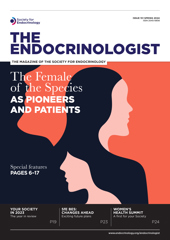Associate Professor Morag Young is Head of Cardiovascular Endocrinology at the Baker Heart and Diabetes Institute, Melbourne, Australia. Morag is also Deputy Editor of two Society for Endocrinology journals: Journal of Endocrinology and Journal of Molecular Endocrinology. We caught up with her to learn about her career in endocrinology, her role as Deputy Editor, and the women who have inspired her.
Please can you tell us about your research role?
I am a research group leader at the Baker Heart and Diabetes Institute in Melbourne, Australia. My group seeks to identify and understand novel mechanisms of mineralocorticoid receptor disease in cardiovascular disease and diabetes.
Our ongoing studies include preclinical as well as clinical work, which is supported by state-of-the-art platform technologies and clinical connections at the Baker Institute. I moved to the Institute in 2020 with my lab, as the first Alice Baker and Eleanor Shaw Gender Equity Fellowship recipient. This fellowship was created by the Baker Institute, as a proactive step to recruit and support senior female researchers and to address the large imbalance in mid-career and senior women working as research leaders. We are seeing more change in the sector overall with developments in the National Health and Medical Research Council funding policy, and I hope that this continues to support equity, innovation and exciting research for all.
I am also very fortunate to have a wonderful team of early career researchers and PhD students. We welcome new undergraduate researchers and medical students to our lab each year, to continue building our work and exploring new directions. Mentoring junior researchers is a key highlight.
What attracted you to a career in endocrinology?
The exciting data from my first study as an undergraduate cemented my aspirations to become a medical researcher. Understanding how hormone receptors work, particularly the mineralocorticoid receptor, was fascinating. I always suspected that it played a lot more roles in physiology/disease, but we needed the models to be able to identify these and understand their importance in physiology. It is very exciting to be able to use new developments in technologies to expand our research, as is the potential for new discoveries in cell systems that were previously not possible.
What have been your career highlights so far?
One has definitely been seeing mineralocorticoid receptor antagonists go into clinical trial following our first studies of aldosterone in cardiac fibrosis, and then progress to guideline recommended therapy for heart failure. Another highlight was identifying the interaction between the mineralocorticoid receptor and the circadian clock. We were also first to show that mineralocorticoid receptor action in the macrophage is a critical regulator of cardiac inflammation and fibrosis. This was an exceptionally novel finding, and we won an award from the American Heart Association.
Meeting other medical researchers around the world who are also dedicated to understanding the mineralocorticoid receptor, glucocorticoid receptor and other steroid receptors in biology and disease is always a highlight. I also enjoy working as Deputy Editor for the journals! It is a very different experience, but very rewarding, and it has led to new research collaborations.
Have any inspirational women had an impact on your career?
Yes, plenty! I met Gail Adler (Brigham and Women’s Hospital, Boston, MA, USA) and Elise Gomez-Sanchez (University of Mississippi, Jackson, MS, USA) as a first year PhD student while travelling to a conference. They were very welcoming and clearly very energetic, clever, hard-working and successful researchers, but they also never missed a chance to teach me something, in terms of theory or in the lab (I learned new surgery techniques from Elise). They also both have families and make it all work! Both have been constant supports for me professionally and personally, and I am very grateful for their friendship and collegiality.
I am constantly inspired by my PhD students – this mentoring business is a two-way process! I also have two daughters who are really keen on science and desperately want to work in my lab, so we have a lot of fun talking science at home too.
What does your role as Deputy Editor of the journals involve?
I was delighted to be invited by Adrian Clark to join Journal of Endocrinology and Journal of Molecular Endocrinology as a Senior Editor some years ago. While trying to suppress a severe case of imposter syndrome, I spent my early months learning as much as possible and asking for help often. The Editorial Office and Editors at each level all work as a team to publish the best science, offer constructive criticism where needed, and help authors to present their work at the highest standard. The focus on quality permeates everything we do. With changes in Editors-in-Chief, we have also seen new initiatives take off, and this is really important in order for the journals to evolve within the changing publishing landscape.
What advice would you give to researchers submitting articles?
A great starting point is to look at the scope description for the journals. This has just been updated and will give you a great idea about what type of work the journals publish. It has also been expanded slightly, so it is a good idea for those familiar with the journals to check what is new. If you are not sure, just send an email to the Editorial Office; they are very helpful and friendly!
I really like our new initiative for Rising Stars, started by Karen Chapman, where we seek out and showcase reviews and work from early- and mid-career researchers – we’re providing an important platform for the next generation of talent in our field.
Find out more about publishing in Journal of Endocrinology
Find out more about publishing in Journal of Molecular Endocrinology





